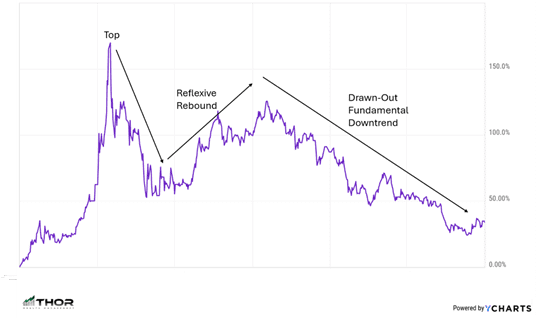10 Rules of Investing – Part 3
Blog post
06/12/24In the first two parts of this series (Part 1 & Part 2), we explored six of Bob Farrell’s rules of investing, highlighting the importance of market cycles, sentiment, and valuation. As we delve into the final segment, we’ll examine rules 7 through 10, which offer insights into market breadth, consensus views, and the phases of a bear market. These principles provide a comprehensive framework for navigating the complexities of investing.
Rule 7: Markets are strongest when they are broad and weakest when they narrow to a handful of blue-chip names.
A market rally is strongest when a wide array of stocks across various sectors participate, indicating robust market health and investor confidence. Conversely, a rally driven by a few large-cap stocks suggests underlying market weakness and a higher risk of correction. Broad market participation helps mitigate risk and signals a more sustainable uptrend. The S&P 500, which is weighted based on market cap, may not be the best representation of the strength of the entire market. With such a high concentration in the large-cap tech companies, it is important to understand that the performance of the index is not necessarily indicative of the overall strength of the market. The small and mid-sized companies are the true drivers of bull markets.
Rule 8: Bear markets have three stages – sharp decline, reflexive rebound and a drawn-out fundamental downtrend.
Bear markets tend to follow a similar pattern, typically unfolding in three stages. After the initial selloff, there is usually a rebound known as a “sucker’s rally” or a “bull trap,” which is often speculative and short-lived. It gives an illusion that the market overreacted, and buyers emerge following the initial drop. This is followed by a prolonged fundamental downtrend, characterized by a deterioration of the underlying market or company fundamentals. Understanding these stages can help investors recognize the phases of a bear market and avoid being misled by temporary recoveries. It is important to remain patient and vigilant during bear markets to make informed investment decisions.

Rule 9: When all the experts and forecasts agree – something else is going to happen.
When all experts and forecasts align, it can sometimes signal that the market is about to take an unexpected turn. Consensus on a bullish trend can indicate that the market is overvalued and primed for a correction. Conversely, unanimous bearish predictions may suggest that the market is undervalued and on the brink of a rebound. We must remember that market prices are based on future expectations, and if expectations are all positive, then things can be seen as being “priced to perfection.” If the actual outcomes are not in line with the expectations, prices will fall. Farrell’s ninth rule encourages investors to remain cautious and to critically assess the prevailing sentiment of the market.
Rule 10: Bull markets are more fun than bear markets.
Bull markets are the best—unless you’re a short seller. Who doesn’t like making money?
Conclusion
Bob Farrell’s 10 Market Rules offer a guideline for understanding market trends. They emphasize the cyclical nature of markets, cautioning against the belief in permanent shifts and highlighting the influence of emotional factors such as fear and greed. Farrell also stresses the importance of market breadth and the typical progression of bear markets through three stages. Ultimately, these rules provide investors with a game plan for making decisions and maintaining discipline in the long run.
If you have questions and would like to talk with us further, please call us at 513-271-6777. For more THOR reading, click here to go to the Blogs and Market Updates section on our website. Follow us on social media: